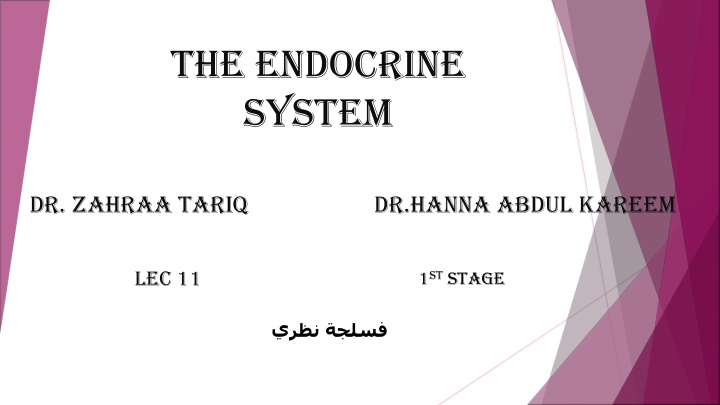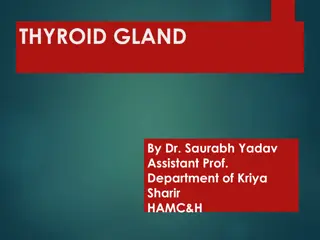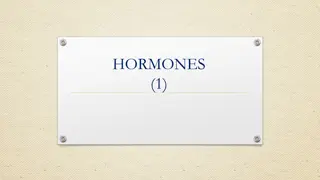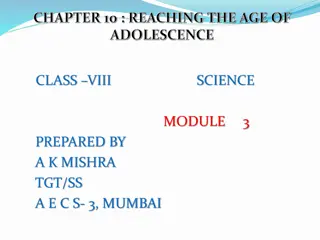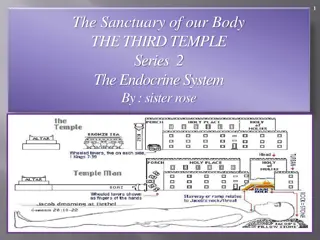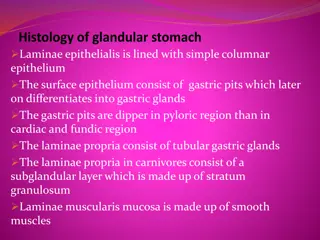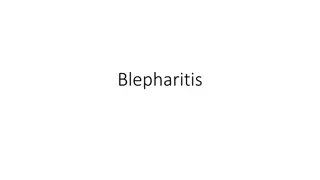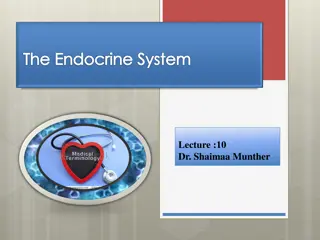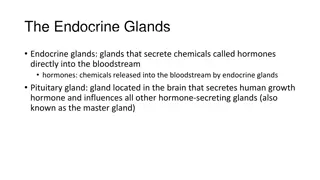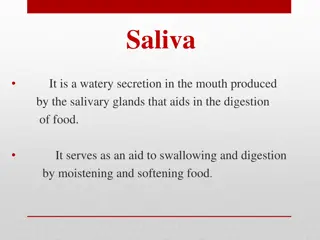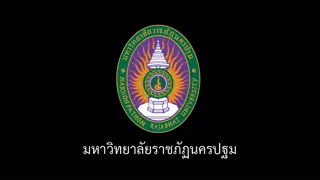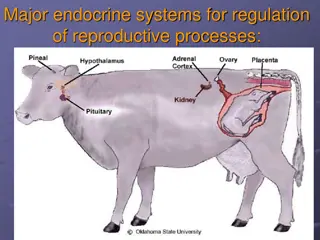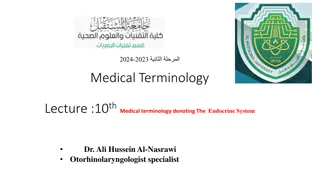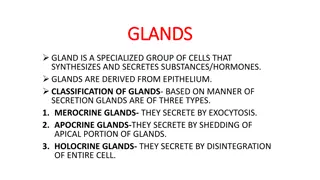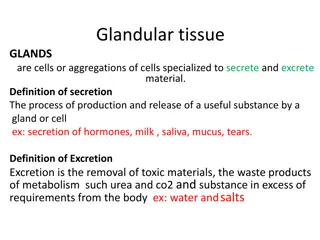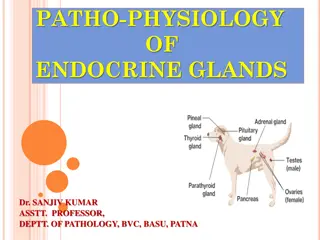Endocrine System: Glands, Hormones, and Functions
The endocrine system comprises various glands that produce hormones, influencing different body parts and functions. Explore the roles of glands like the hypothalamus and pituitary gland in regulating hormones, growth, and more. Learn about hormone secretion, including growth hormone, prolactin, thyroid-stimulating hormone, and others. Dive into the functions of hormones like luteinizing hormone, adrenocorticotropic hormone, oxytocin, and antidiuretic hormone in the body.
Download Presentation

Please find below an Image/Link to download the presentation.
The content on the website is provided AS IS for your information and personal use only. It may not be sold, licensed, or shared on other websites without obtaining consent from the author.If you encounter any issues during the download, it is possible that the publisher has removed the file from their server.
You are allowed to download the files provided on this website for personal or commercial use, subject to the condition that they are used lawfully. All files are the property of their respective owners.
The content on the website is provided AS IS for your information and personal use only. It may not be sold, licensed, or shared on other websites without obtaining consent from the author.
E N D
Presentation Transcript
The endocrine system Dr. Zahraa Tariq Dr.Hanna Abdul Kareem Lec 11 1st stage
Endocrine System : a system of glands The Gland: a group of cell that produce or secrete chemicals( called hormones) directly into the blood stream. Hormones can be transported to other part of the body where they influence cells ,organ and function of the body. Organs of Endocrine System: 6. Parathyroid Hypothalamus 1. 7. Pancreas Pituitary gland 2. 8. Adrenal Pineal gland 3. 9. Ovaries Thymus 4. 10.Testes Thyroid 5.
Hypothalamus The hypothalamus is a small organ, which lies deep within the center of the brain. It plays an important role in a wide variety of physiological functions, including: 1. Regulation of pituitary hormones( hypothalamus stimulates release and inhibition of pituitary hormones). Regulating body temperature. 2. Control of thirst and appetite. 3.
Pituitary Gland Pituitary Gland also called hypophysis (Master Gland) Physiologically divided into two parts : The Adenohypophysis (Anterior Pituitary). The Neurohypophysis (Posterior Pituitary). The Neurohypophysis is innervated by nerve cells in the hypothalamus.
Hormones Secreted by Anterior Pituitary: Growth Hormone(GH) controls physical development and growth. 1. It has the ability to promote growth in practically all tissues. Bones and muscles are its specific targets. Prolactinstimulatesbreast tissue to produce milk. 2. Thyroid-stimulating Hormone(TSH) activates thyroid gland to 3. release thyroid hormones. Follicle-Stimulating Hormone(FSH): 4. In women involved with estrogen secretion and the growth of egg cells . In men important for sperm cell production .
5. Luteinizing Hormone(LH) In women(ovary) : production of estrogen In men(testes): production of testosterone Adrenocorticotropic Hormone(ACTH) stimulates adrenal 6. glands to produce cortisol and other hormones. Melanocyte-stimulating Hormone (MSH) : 7. stimulate increased pigmentation of skin in response to exposure to UV (ultraviolet radiation).
The Neurohypophysis (Posterior Lobe): The hormones secreted from posterior lobe are typically made in the hypothalamus, transmitted through nerve axons, and stored in the posterior lobe until they are released. These hormones are : Oxytocin: 1. Stimulates the release of breast milk. It also stimulates contractions of the uterus during labor. Antidiuretic Hormone (ADH)(also called Vasopressin) : 2. It helps in the saving of water and the prevention of dehydration in the body.
Thyroid gland The thyroid gland is a ductless alveolar gland found in the anterior neck, just below the laryngeal prominence (Adam s apple). It is butterfly-shaped, with two lobes wrapping around the trachea and connected in the middle by an isthmus. The thyroid gland is not usually palpable. The thyroid gland is one of the largest endocrine gland , it secret two hormones Thyroxine T4 Triiodothyronine T3
Physiological Effect of Thyroid Hormone 1. Increase basal metabolic rate and heat production through:- a) Increase Gluconeogenesis and Glycogenolysis. b) Increase Lipogenesis. 2. Increase heart rate 3. Increase appetite. 4. Stimulate growth hormone secretion and promote growth hormone effect. 5. Affecting brain development during fetal and postnatal life.
Adrenal Gland Adrenal gland (also called suprarenal gland ) are small triangular gland located at the top of both kidneys. Adrenal glands are composed of two parts: 1. The Adrenal Cortex is the outer region and also the largest part of an adrenal gland. It is subdivided into three separate zones. Zona Glomerulosa A. Zona Fasciculata B. Zona Reticularis C. 2. The Adrenal Medulla is located inside the adrenal cortex in the center of an adrenal gland. ) The adrenal medulla, the inner part of an adrenal gland, controls .
The Adrenal cortex The Adrenal Cortex is composed of three separated zones: Zona Glomerulosa: 1. Aldosterone hormone production. Aldosterone causes the kidneys to absorb more salt into the bloodstream while releasing potassium into the urine. It is important in the regulation of blood pressure and certain electrolytes (sodium and potassium).
2. Zona Fasciculata: Secrete Cortisol, which acting by:- 1. Increase blood glucose level. 2. Promote the catabolism of protein. 3. Increase fat mobilization from adipose tissue. 4. Maintain water balance in the body. 5. Increase sodium retention and potassium excretion through kidney.
3. Zona Reticularis: Secrete DHEA and Androgenic Steroids They are precursor hormones that are converted in the ovaries into female hormones (estrogens) and in the testes into male hormones (androgens). However, estrogens and androgens are produced in much larger amounts by the ovaries and testes.
The Adrenal Medulla It secret stress hormones that includes: Epinephrine (Adrenaline) 1. Norepinephrine (Noradrenaline). 2. These hormones enhance the fight or flight response that initiated by sympathetic stimulus. Functions of Stress Hormone:- 1. Increasing the heart rate. 2. Increasing blood flow to the muscles and brain. 3. Relaxing airway smooth muscles. 4. Increase gluconeogenesis . 5. Increase blood pressure.
